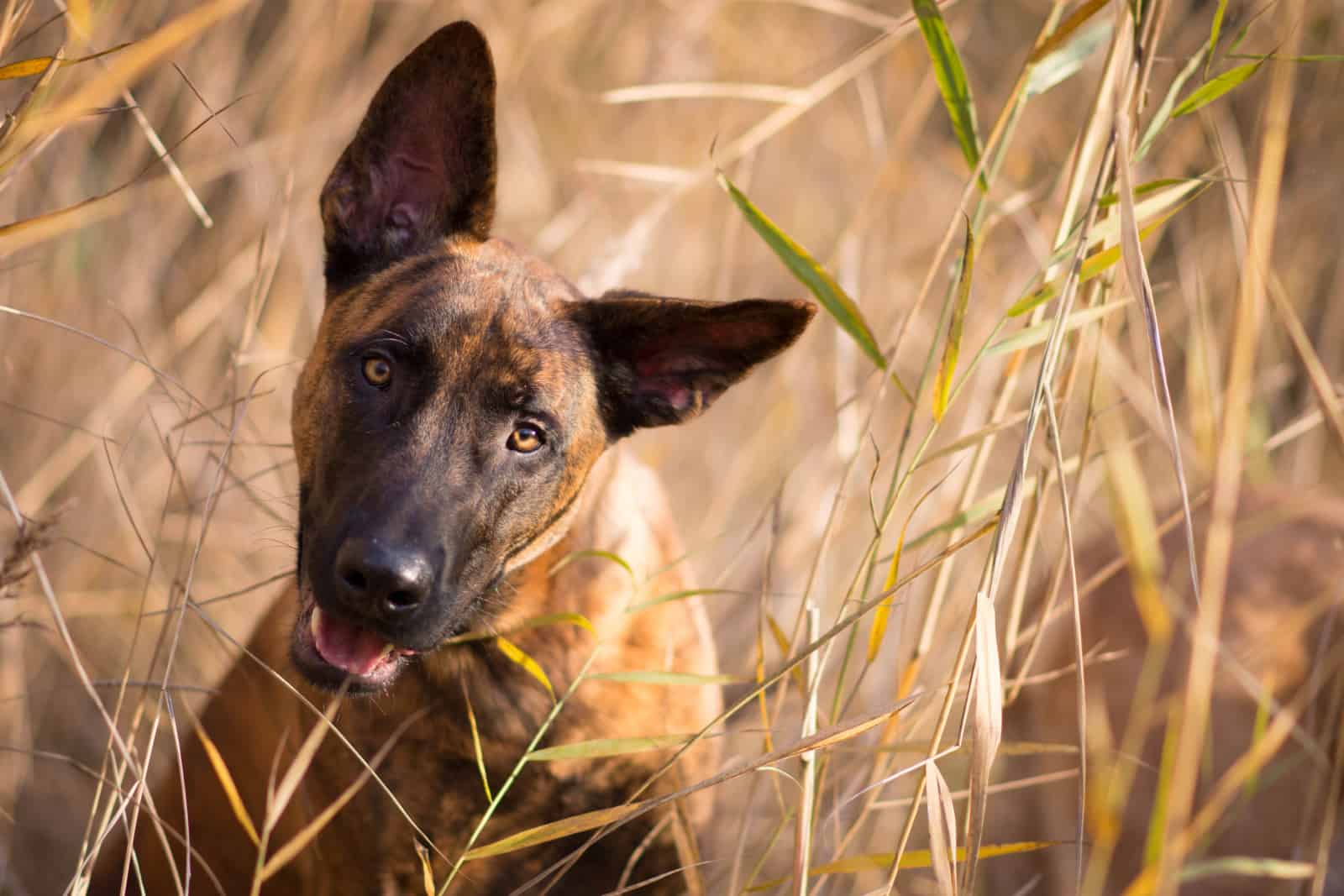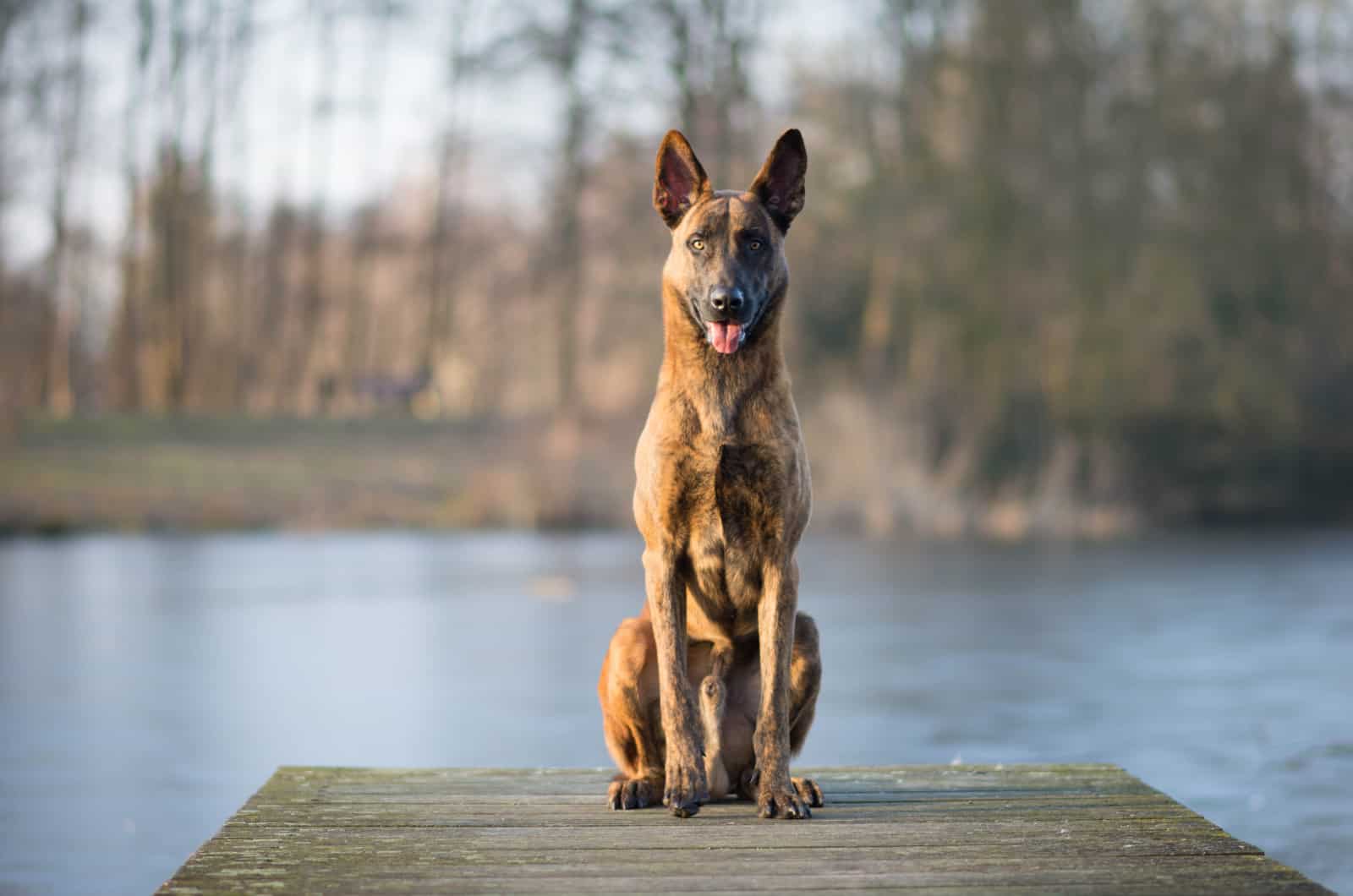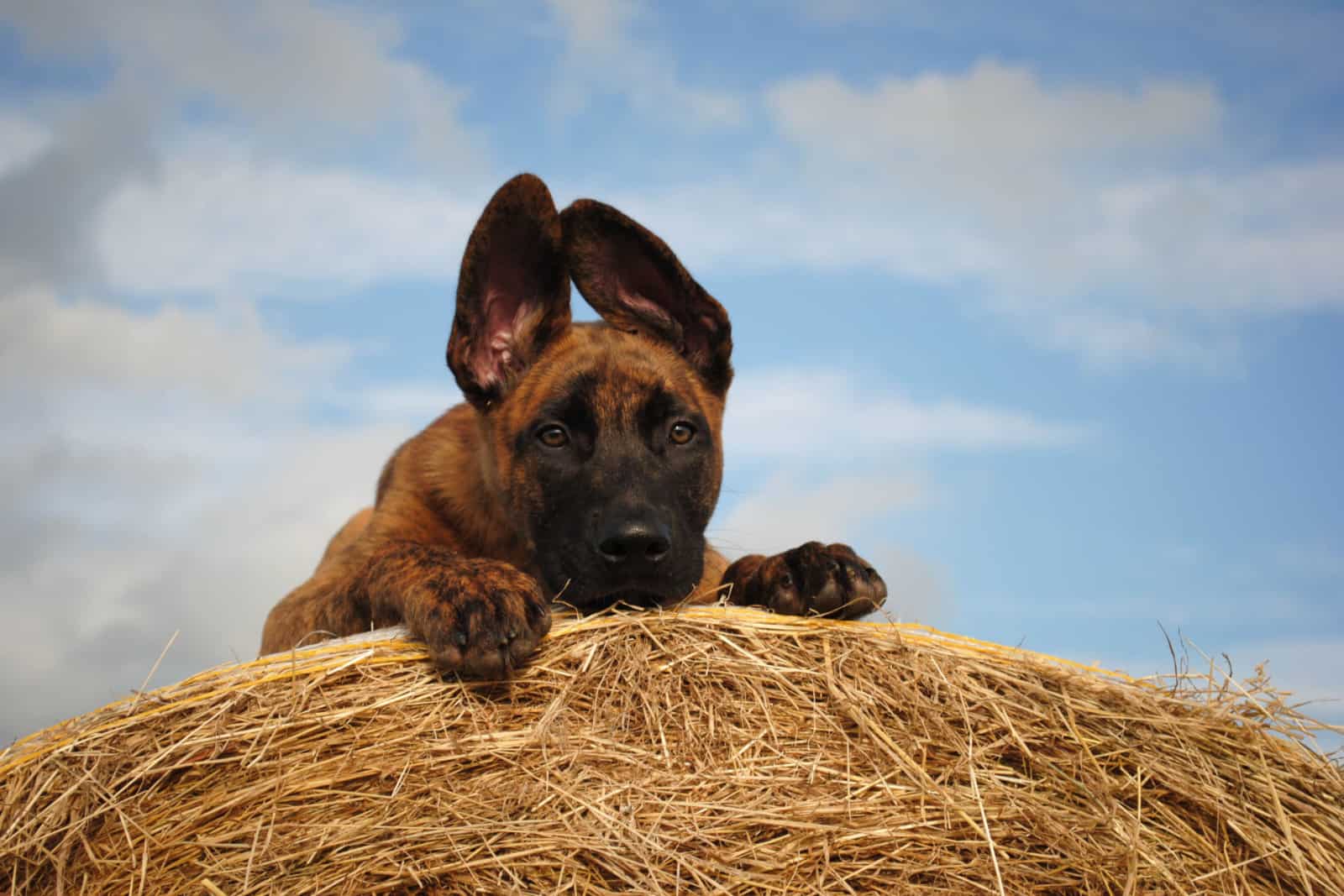Have you ever considered the idea of having a Dutch Shepherd puppy in your home? If so, it’s always nice to know what to expect out of your puppy in terms of its size.
Although being medium to large dogs, these canines are generally recommended for families with a spacious home as Dutch Shepherds naturally crave space and activity.
Despite having much in common with Belgian Shepherds and German Shepherds, these pooches are somewhat smaller, which makes them even more favorable for having indoors.
However, the puppy needs proper healthcare, nutrition, and training in order to remain within its ideal size.
After digging into the Dutch Shepherd growth chart, we’re going to explain each of its growth stages in detail. But first, let’s see the numbers!
The Dutch Shepherd Growth Chart

[table id=713 /]
According to the American Kennel Club, the average size of a Dutchie in its adulthood revolves between 42 and 75 pounds in weight, and 21.5 to 24.5 inches in height. As we can see from the chart above, the ideal weight of the puppy revolves between 60 and 65 pounds.
When comparing A Belgian Malinois with A Dutchie, we can see that the latter is smaller by a few pounds and inches, which makes these pooches ideal for an indoor life. On the other hand, the Dutch Shepherd dog needs regular outdoor activity to burn off its energy properly.
Now, let’s see what the Dutch Shepherd growth chart looks like in each of its growth stages.
Dutch Shepherd: Growth Stages Explained

There are several significant growth stages in terms of the Dutch Shepherd growth chart: early puppyhood, late puppyhood (or juvenile age), adolescence, and adulthood and senior years.
Each of these stages are equally important as each carries a significant number of changes related to that age. However, in order to have a high-quality puppy in your home, you should pay special attention to its puppyhood stage.
In that regard, getting your new pet from a reputable Dutchie breeder will be beneficial as those breeders subject their newborn litters to early health examinations, vaccinations and deworming, as well as DNA testing.
These things are crucial for the proper development of a puppy, especially if the puppy has a genetic tendency of developing major health issues such as hip dysplasia, gonio dysplasia (fluid in the eye not draining properly), cryptorchidism, or hypothyroidism.
Unhealthy puppies generally have a lower life expectancy, and they usually cannot perform physically as well as their healthy counterparts.
From Birth To Two Weeks
The first two weeks of a puppy’s life are highly essential to their overall development. This is the time when puppies first open their eyes and start whining.
By the end of the first week, you can expect to see the first rudimentary crawling in your puppy. However, this is still early for a puppy to learn how to bear their head properly. That’s why it is completely normal to see a puppy crawling normally at three weeks of age.
During this age, it is crucial to keep them with their mother and other littermates, which is why it is never recommended to pick them up from a breeder before the age of eight weeks.
The only food they need during the first two weeks is their mother’s milk. If you have a whole litter in your home, make sure that each puppy has access to this milk as there are some puppies that are naturally weaker.
However, if you saved a newborn puppy from a street – a puppy formula and a milk replacer are the only things that could nearly replace its mother’s milk. Never feed a puppy with regular cow’s milk as this can affect its stomach and its overall health in the long term.
Furthermore, keeping puppies in a warm place (85-90°F) is crucial for maintaining their body temperature.
By the end of this period, expect to see the first teething symptoms in your puppy. This is a sign that your puppy is slowly transitioning into its weaning phase. However, not all puppies grow the same, which is why the weaning phase for some puppies starts at three or four weeks of age.
From Three Weeks To Six Months
The weaning phase usually starts at three weeks of age, which is the ideal time to start giving your puppy solid food. A gruel made of a milk replacer and puppy food is a good place to start.
As puppies at three to four weeks of age are able to walk, this is the ideal time to start training them. Early socialization and obedience training are the keys to a loyal, affectionate, and well-mannered pet in the future.
Even though this breed is not as easy to potty train as their GSD cousins, Dutchies are extremely intelligent dogs. Their overall training process is not overwhelming, which makes them ideal for search and rescue, herding, and even military purposes.
Both female and male Dutch Shepherds are naturally a working dog breed. They need mental stimulation from an early age to stay focused and occupied. On the contrary, these pooches can have behavioral outbursts that result in aggressiveness.
At the age of seven to eight weeks, you should start giving your dog dry kibble. However, make sure to regularly brush its teeth in order to eliminate plaque buildup and bad breath.
From Seven Months To Twelve Months

At the age of six to seven months, Dutchie puppies start entering their adolescence, or popularly known as sexual maturity age. This is the period when a dog starts acting weird at times as they become sexually frustrated.
That being said, the ideal time to spay or neuter your pet is between six and twelve months of age. Otherwise, you might face sudden outbursts and occasional aggressiveness.
Spaying or neutering a dog after the first year is much more complex as the surgical procedure is more painful, and it takes more time for the puppy to recover.
Puppies between seven and twelve months of age generally weigh 50 to 60 pounds, while their height revolves between 18 and 21.5 inches. This is almost a grown-up dog in terms of its size, but the puppy is still immature mentally.
However, the most obvious growth spurts are visible by the age of six to seven months. Afterwards, the puppy has a slower growth towards its adult size.
Dutchies at seven months of age have a lot of energy that needs to be burned off. In order to maintain their activity level – make sure to subject them to at least one hour of training a day. Otherwise, they can become hard to train.
Improperly-trained Dutch Shepherd dogs can be mischievous at times, just like a Siberian Husky or a Dachshund.
From Twelve Months To Eighteen Months
Puppies at twelve months of age are already expected to be fully socialized and trained for indoor life. Otherwise, socializing an aggressive dog in their adult age can be a true nightmare.
At this age, most Dutchies are already fully grown, which means that they will be between 60 and 65 pounds heavy, and 21.5 to 24.5 inches tall. Still, some dogs reach their full size by the end of the 18th month.
Bear in mind that at the age of twelve months, your dog will be a fully active dog that will require hour-long training on a daily basis. These are not couch potato dogs that enjoy laying around the house for the most part of the day.
At one year of age, Dutchies are fully capable of being multipurpose farm dogs. Still, bear in mind that they reach their full mental maturity after the first two years. At the age of one, Dutchies still need a lot of mental training.
Positive reinforcement techniques such as praising, petting, and giving them snacks for the successful completion of tasks are an excellent way to keep them positive and stimulated. Despite the fact that they need firm leadership, these puppies respond to positive reinforcement great.
Adult Dutch Shepherd
The adulthood phase is considered to be the period after the first two years of a Dutchie’s life. This is the time when your dog becomes fully grown, both physically and mentally. Adult Dutchies are ideal herding dogs, but they also excel in search-and-rescue and military tasks.
However, Dutchies also make excellent family dogs as long as they are socialized and obedience trained. Adult Dutchies are naturally loyal, affectionate, and devoted to their family. Their relationship with small children is wonderful as they generally have a high level of tolerance.
In a way, we can say that Dutchies are much better at being indoor, family dogs than their Belgian and German cousins. These canines that originally come from the Netherlands are perfectly adaptable dogs that love spending time with their loved ones.
However, do not neglect their needs, even in their adulthood as they still need regular outdoor activity. Keeping them occupied with interactive dog toys in a house is good, but the puppy is a natural farmer that seeks fresh air and a field to spread its legs.
An adult dogs’ ideal size is 60 to 65 pounds in weight, and their height generally reaches up to 24 inches. However, it is completely normal to have a Dutchie under 60 pounds as long as it doesn’t go below 45 pounds in weight.
As the average lifespan of a Dutchie is 11 to 14 years, you can expect your puppy to enter its senior years at age 10.
5 Factors Affecting The Dutch Shepherd’s Growth

Unlike GSDs or Belgian Malionis dogs that happen to be among the healthiest breeds in the world, Dutch puppies can face several health problems such as hip and elbow dysplasia, goniodysgenesis, cryptorchidism, various allergies, and even hypothyroidism.
These are the problems that have a positive correlation with the puppy’s development, which is why dog owners should always pay attention to their dogs’ health. The best way to avoid hereditary diseases is to buy a dog from a reputable breeder.
Aside from health, there are several other factors that impact the Dutch Shepherd growth chart. Five most important factors are genetics, feeding (nutrition), health, gender, and exercise.
1. Genetics
Genetics plays a crucial role in the Dutch Shepherd’s growth chart. In order to predict their physical predispositions, as well as their character, dog owners should always pay attention to their puppies’ parents.
Genetics determines a dog’s coat type, coat color, eye color, weight chart, temperament, and future health problems. Conditions, such as hip and elbow dysplasia, or hypothyroidism are hereditary issues picked up from the Dutchie’s parent breeds.
Even though brindle, salt and pepper, gold and brindle, and silver and brindle are the breed standard in terms of color patterns, you can come across a blue Dutch Shepherd, too. The reason why some Dutchies have an unusual coat color is mostly due to their genetics.
The best way to avoid unpleasant surprises in the future is to choose a reputable Dutchie breeder. High-quality breeders subject their puppies to early genetic testing, which is why it is highly unlikely to get a dog with some sort of deformation.
2. Feeding
Nutrition is an important part of a Dutchie’s growth. Even though this is a highly active dog breed, these canines require a properly established feeding chart to remain healthy.
As long as you give them high-quality food, and stay away from the worst dog food brands on the market – your dog will be just fine.
However, nutrition is in a codependent relation with exercise. Making a lazy dog out of your Dutchie will have a negative impact on its adult weight. Laziness is directly related to obesity, which can trigger a plethora of health issues in the future.
Obesity, heart failure, and diabetes are just some of the issues that an inactive Dutchie can face. On the other hand, puppies that don’t have well-planned meals might face bloat.
Furthermore, underfed dogs will be just as affected as overfed ones. Giving your dog a sufficient amount of food in each of its growth stages is crucial for its bone and muscle development.
Pay special attention to calcium and carbonate intake during the puppyhood stage.
On the other hand, puppies older than seven months of age will need additional protein intake for proper muscle development.
3. Health

Keeping your dog healthy is in direct relationship with its growth. There are three things that every responsible owner should pay attention to. First, you should always take into consideration your puppy’s dietary needs.
Secondly, give the Dutchie as much exercise as it needs. That way, you will keep your puppy mentally stimulated and physically active.
Lastly, subjecting your dog to regular vet examinations is crucial for anticipating potential health issues. As soon as you notice irregularities in your dog, you should pay your vet a visit.
However, there are some health issues that affect the Dutchie’s growth regardless of your daily care. For instance, hypothyroidism in dogs can be the reason why some dogs are bigger than others.
Furthermore, puppies with hip and elbow dysplasia are more likely to gain some additional weight as they are inactive, lethargic, and incapable of meeting their daily exercise needs. That’s why a dog with hip or elbow dysplasia should never be overfed.
On the other hand, puppies with cancer are most likely to lose weight in the long run. Unfortunately, this issue generally has deadly repercussions, and there is not much to do in that regard.
Aside from cancer, dog parasites can be the reason why some dogs lose weight significantly.
4. Gender
Gender plays a significant role in a dog’s growth. Generally, male Dutchies tend to be slightly larger than their female counterparts.
On the other hand, you can expect your female Dutchie to stop growing before the male one as females generally reach their mental maturity faster than males.
The difference between these two genders is obvious and visible, even by the untrained eye. Male Dutchies generally outgrow females by a couple of inches, while their weight goes five to ten pounds up.
This is not always the case as there might be rare situations when female Dutch Shepherds are bigger than their male counterparts. However, this is highly unlikely, and it is often triggered by some sort of health abnormality.
However, both male and female Dutchies make almost equally active shepherd dog breeds, which means that there is little or no difference at all in terms of their activity level.
5. Exercise
Even though this is mostly a medium-sized dog that adapts to indoor life easily, Dutchies do not belong to the group of lazy dog breeds by default.
On the contrary, these pooches need regular activity during the day in order to burn off all the energy they have. However, skipping daily exercise can make a lazy couch potato out of your Dutch Shepherd, which can have a negative impact on its growth.
Inactive Dutchies are more likely to be fatter and bigger than their regularly-exercised counterparts. However, this is not a positive thing as inactivity leads to obesity and other health problems.
Furthermore, a negative side-effect of a Dutchie’s laziness is occasional aggressiveness. You shouldn’t gamble with that!
FAQs

1. At What Age Is A Dutch Shepherd Fully Grown?
Generally, these canines are fully grown at two years of age, both physically and mentally.
However, there are Dutchies that reach their adult size during the first twelve months of age, which is not rare.
Still, you cannot expect your dog to be mentally mature at the age of twelve months as they still have quite a long way to go. Typically, all dogs that look like GSDs, including Dutchies, need a lot of mental stimulation during the first two years of their life.
Afterwards, you can expect your Dutchie to be firm, loyal, obedient, and well-behaved.
2. What Is the Average Weight Of A Dutch Shepherd?
The average weight of a Dutchie revolves between 42 and 75 pounds. However, the ideal size of a fully-grown Dutchie is somewhere between 60 and 65 pounds. This is a medium to large dog breed that needs proper nutrition in order to stay healthy.
Otherwise, improper feeding can be a direct reason why some Dutchies are below their estimated growth rate. Not only that, but underfed dogs are generally smaller than regularly-fed Dutchies, and they are also significantly weaker and have poor athletic potential.
If you don’t know how heavy your dog should be, take a look at the Dutch Shepherd growth chart above.
On the other hand, the weight of a Dutch Shepherd can be affected by several other factors such as health, genetics, gender, and exercise.
Conclusion
The Dutch Shepherd growth chart is a good indicator of how heavy your Dutchie pet should be. It helps you determine the average weight and height of your dog during each of its growth stages, including puppyhood, the juvenile age, adolescence, and adulthood.
However, its growth is sometimes affected by several external factors such as health, genetics, feeding, exercise, and gender. Still, as long as your puppy is within the normal weight and growth ratio, you have nothing to worry about.
But, if you notice excessive weight gain, or weight loss, as well as irregular development of your puppy – you should seek veterinary help.
Read next: Whippet Growth Chart — Is My Whippet Normal?
